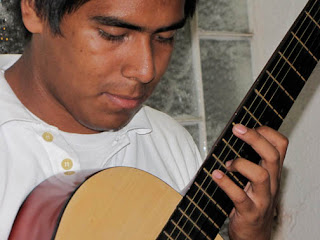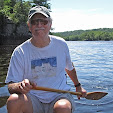 A/C and only a few fans placed here and there, the heat sapped my concentration. I had little interest in discussing the exhibits or anything in English, not to mention Spanish. Sweat poured down my body; every step I made was checked by the sticking of my pants to my thighs. Just as I was about to rush out of the building for some
A/C and only a few fans placed here and there, the heat sapped my concentration. I had little interest in discussing the exhibits or anything in English, not to mention Spanish. Sweat poured down my body; every step I made was checked by the sticking of my pants to my thighs. Just as I was about to rush out of the building for some  breezy shade, a museum guide, recognizing Nancy and me as easy victims, grabbed us to use as models in her explanation of early 20th century social niceties to a group of elementary school kids. The poor woman and the other adults taking in her tour tried to make us feel part of the whole thing, but I must have looked as pre-occupied as I felt.
breezy shade, a museum guide, recognizing Nancy and me as easy victims, grabbed us to use as models in her explanation of early 20th century social niceties to a group of elementary school kids. The poor woman and the other adults taking in her tour tried to make us feel part of the whole thing, but I must have looked as pre-occupied as I felt. This afternoon, finally, relief! As the norte blew in, the sky clouded up, a fierce wind rattled windows and signs, wind-blown whitecaps shredded the Gulf, and by 4:00 the temperature had dropped to a refreshing 80 degrees.
This afternoon, finally, relief! As the norte blew in, the sky clouded up, a fierce wind rattled windows and signs, wind-blown whitecaps shredded the Gulf, and by 4:00 the temperature had dropped to a refreshing 80 degrees.Tonight, Jorge (the wonderful young charlante I'd met my first day at school) was back on duty in the student lounge. While I waited for Eric and Linda to return from their daily constitution and let me into my room (in which I'd locked my key)
 Jorge and I had a wonderful conversation on a wide range of topics. (While some of my sentences are still a bit halting for lack of the right word or tense, I'm really proud of the way my speaking and listening skills have been shaping up!) Then Jorge picked up the guitar Eric keeps in the lounge and quietly played several more of the gorgeous classical pieces he's mastered.
Jorge and I had a wonderful conversation on a wide range of topics. (While some of my sentences are still a bit halting for lack of the right word or tense, I'm really proud of the way my speaking and listening skills have been shaping up!) Then Jorge picked up the guitar Eric keeps in the lounge and quietly played several more of the gorgeous classical pieces he's mastered.Tomorrow, I try to find my way up to Naolinco de Victoria, a couple of hours and a couple of bus legs north of here. I'd come across information about the mountain village on the web, saying that its Dia de los Muertos celebrations are unusually rich and welcoming to visitors. Luckily, I and Genny, who decided she'd like to join me, were able to secure, several weeks ago, the last two hotel rooms in town. It should be a real adventure— we might be welcomed with open arms into people's homes to see their elaborate, tradition-steeped altars honoring their difuntos (deceased loved ones). Or we might feel we're intruding, hold back and wish we'd not devoted our weekend to the effort. As the Mexicans say, sea como sea, we'll see.
Around here in Puerto Veracruz, we've already seen quite a few altars being built and decorated, pan de muerto (bread made only for this occasion), skull and skeleton costumes and trinkets, and of course the flor de muerto, the special marigolds (zempasuchitl in Náhuatl, language of the Aztecs) always used for decoration.
NOTE: I'll not be able to post for the next two days, since I've decided not to take my computer on what might be a pretty rough ride. But I promise to share whatever impressions and photos I come up with in my weekend in Naolinco.
By the way, Happy Halloween to all you norteamericanos!























